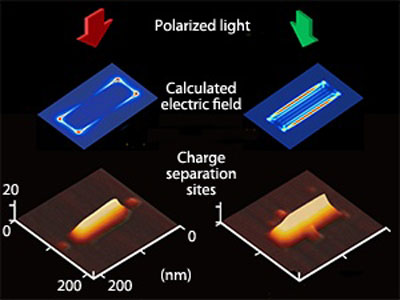| Jul 19, 2011 |
Surface plasmons: playing the field
|
|
(Nanowerk News) Surface plasmons, or the collective oscillations of electrical charge on the surfaces of metals, are of considerable interest to scientists primarily for their potential to control light on the nanoscale, far beyond the limits of conventional optics. At such minute dimensions, however, the precise properties of the individual plasmonic resonances are difficult to determine. Emiko Kazuma, Nobuyuki Sakai and Tetsu Tatsuma from the Institute of Industrial Science at the University of Tokyo in Japan have now developed a technique for imaging the electrical charge separation sites of individual plasmonic nanoparticles, which could lead to better tuning of their plasmonic properties ("Nanoimaging of localized plasmon-induced charge separation").
|
 |
| Imaging plasmonic charge separation.
|
|
The electromagnetic fields of plasmonic nanostructures can take complex forms and are strongly influenced by factors such as the wavelength of light or the geometry of the metallic nanostructures. Tatsuma and his colleagues overcame the difficulty in imaging these nanoscale fields by developing an indirect approach. They grew plasmonic silver nanostructures on titanium dioxide to construct a system in which plasmon-induced electric charges in the silver transfer to the titanium dioxide. In a humid atmosphere, the silver ions formed by this charge transfer become dissolved in water adsorbed to the sample surface and redeposit on the titanium dioxide surface as silver nanoparticles.
|
|
As the number of dissolved silver ions depends directly on the number of electronic charges, the distribution of these silver nanoparticles around the plasmonic structure is an indicator of the original electric field distribution. Imaging these nanoparticles, which can be easily done using a microscope, then provides an indirect indicator of the electric field distribution (see image).
|
|
This method has important consequences for the development of plasmonic devices, says Tatsuma. "Now we can improve the efficiency of the plasmon-induced charge separation by designing structures where the plasmonic fields are strong." In particular, he adds, this could be used to optimize fabrication processes. As plasmonic structures are typically only a few nanometers in size, small structural deviations have a significant effect on their plasmonic properties. This new methodology could therefore prove to be an important diagnostic tool for scientists in the development of enhanced plasmonic devices.
|

